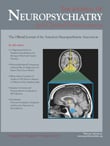Allopurinol May Prolong Seizure Duration on Electroconvulsive Therapy: A Case Report
To the Editor: Allopurinol is indicated not only for the management of patients with hyperuricemia but also as an add-on therapy for refractory epileptic patients because of its anticonvulsant effects. 1 We present a case report of a patient with schizophrenia who underwent ECT while concurrently receiving allopurinol to manage hyperuricemia. The patient’s seizure duration increased after the administration of allopurinol and decreased after the discontinuation of allopurinol. To our knowledge, there is no currently available literature addressing the possibility of prolonged seizure duration on concomitant administration of ECT and allopurinol.
Case Report
A 40-year-old man with a history of schizophrenia was admitted to our hospital because of exacerbated psychosis and physical aggression. Bilateral ECTs three times a week were arranged, and risperidone was administered at a dose of 8 mg/day. The ECT device was Thymatron DGx model. We found that it was difficult to elicit a seizure with an electrical dose of 15% in first ECT treatment, but successful elicitation of a seizure occurred with an electrical dose of 20%. For subsequent ECT treatments, the electrical dose was maintained at 20%, and no further difficulty in the elicitation of seizures was observed. The analysis of the blood sample collected at admission (before the first ECT session) revealed the presence of hyperuricemia, and the patient was placed on allopurinol treatment (300 mg/day) after the fourth ECT session. Allopurinol was discontinued after the tenth ECT session because of the onset of a skin rash on both forearms and the restoration of serum uric acid to normal levels. Interestingly, the patient’s seizure duration increased, rather than decreased, after the administration of allopurinol, which may elicit an anticonvulsant effect. Finally, the patient’s seizure duration decreased after discontinuation of allopurinol.
Discussion
Allopurinol, which inhibits xanthine oxidase, decreases both uric acid formation and purine degradation. 2 Accumulation of hypoxanthine and xanthine may activate hypoxanthine-guanine phosphoribosyl transferase—which is responsible for purine salvage and possibly increase the levels of adenosine and guanosine neuromodulators. 3 Adenosine inhibits the release of glutamate from excitatory neurons and neuronal firing, so it has been proposed as an endogenous anticonvulsant agent. 3
In one retrospective study, 4 the seizure duration in two patients was significantly longer during treatment with lamotrigine when compared with treatment without lamotrigine, but the underlying mechanism was not mentioned.
Evidence suggests that seizure duration is shorter when the electrical dosage is markedly suprathreshold than when it is barely suprathreshold. 5 An agent that increases threshold may prolong seizures, because increasing the threshold might imply that the stimulus used is closer to the threshold and that a stimulus near threshold elicits the longest seizures. 5 In the case reported here, the electrical dosage of 20% may be markedly suprathreshold. Consequently, the patient showed increased seizure duration after the administration of allopurinol, which was possibly caused by the anticonvulsant effect of this drug.
In conclusion, physicians should be aware of the potential anticonvulsant effect of allopurinol when it is used in clinical practice.
1. Togha M, Akhondzadeh S, Motamedi M, et al: Allopurinol as adjunctive therapy in intractable epilepsy: a double-blind and placebo-controlled trial. Arch Med Res 2007; 38:313–316Google Scholar
2. O’Connor JP, Emmerson BT: The treatment of hyperuricaemia and gout. Aust Fam Physician 1985; 14:193–198Google Scholar
3. Brundege JM, Dunwiddie TV: Role of adenosine as a modulator of synaptic activity in the central nervous system. Adv Pharmacol 1997; 39:353–391Google Scholar
4. Sienaert P, Demunter H, Vansteelandt K, et al: Effect of lamotrigine on concurrent electroconvulsive therapy. Eur Neuropsychopharmacol 2006; 16:S348–S348Google Scholar
5. Sackeim HA: The anticonvulsant hypothesis of the mechanisms of action of ECT: current status. J ECT 1999; 15:5–26Google Scholar



